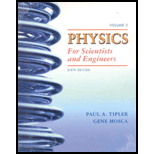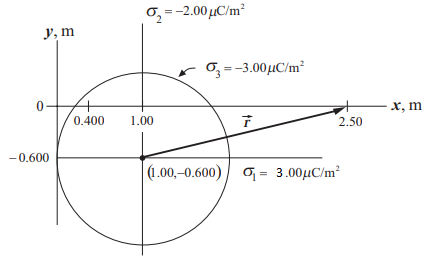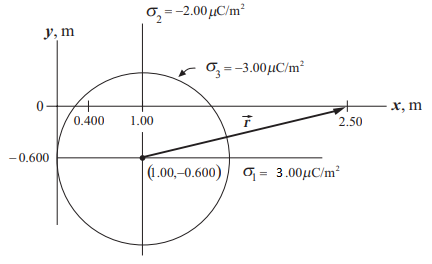
Concept explainers
a.
The magnitude and the direction of the electric field at
The electric field
Given:

The charges are placed as shown in the figure. The first plane at
The surface charge densities are
Formula Used:
Electric field
E is the electric field.
The resultant electric field at point is
Calculations:
The resultant electric field at point is
Electric field at point 1 due to sphere.
As the point is inside the sphere the electric field is zero.
Electric field at point 1 due to plane 1
Substituting values
The electric field at point 1 due to plane 2.
Substituting in the equation
The resultant electric field at point is
Substituting
The magnitude of the electric field is
Direction:
Conclusion:
The electric field
b.
The magnitude and the direction of the electric field at
The electric field
Given:

The charges are placed as shown in the figure. The first plane at
The surface charge densities are
Formula Used:
Electric field
E is the electric field.
The resultant electric field at point is
Calculations:
The resultant electric field at point is
Electric field at point 1 due to sphere.
Where
Electric field at point 1 due to plane 1
Substituting values in the formula
The electric field at point 1 due to plane 2.
Substituting in the equation
The resultant electric field at point is
Substituting
The magnitude of the electric field is
Direction:
Conclusion:
The electric field
a.
Answer to Problem 77P
The electric field
Explanation of Solution
Given:

The charges are placed as shown in the figure. The first plane at
The surface charge densities are
Formula Used:
Electric field
E is the electric field.
The resultant electric field at point is
Calculations:
The resultant electric field at point is
Electric field at point 1 due to sphere.
As the point is inside the sphere the electric field is zero.
Electric field at point 1 due to plane 1
Substituting values
The electric field at point 1 due to plane 2.
Substituting in the equation
The resultant electric field at point is
Substituting
The magnitude of the electric field is
Direction:
Conclusion:
The electric field
b.
The magnitude and the direction of the electric field at
The electric field
Given:

The charges are placed as shown in the figure. The first plane at
The surface charge densities are
Formula Used:
Electric field
E is the electric field.
The resultant electric field at point is
Calculations:
The resultant electric field at point is
Electric field at point 1 due to sphere.
Where
Electric field at point 1 due to plane 1
Substituting values in the formula
The electric field at point 1 due to plane 2.
Substituting in the equation
The resultant electric field at point is
Substituting
The magnitude of the electric field is
Direction:
Conclusion:
The electric field
b.
Answer to Problem 77P
The electric field
Explanation of Solution
Given:

The charges are placed as shown in the figure. The first plane at
The surface charge densities are
Formula Used:
Electric field
E is the electric field.
The resultant electric field at point is
Calculations:
The resultant electric field at point is
Electric field at point 1 due to sphere.
Where
Electric field at point 1 due to plane 1
Substituting values in the formula
The electric field at point 1 due to plane 2.
Substituting in the equation
The resultant electric field at point is
Substituting
The magnitude of the electric field is
Direction:
Conclusion:
The electric field
Want to see more full solutions like this?
Chapter 22 Solutions
Physics for Scientists and Engineers, Vol. 3
- Consider a thin, spherical shell of radius 14.0 cm with a total charge of 32.0 C distributed uniformly on its surface. Find the electric field (a) 10.0 cm and (b) 20.0 cm from the center of the charge distribution.arrow_forwardA solid conducting sphere of radius 2.00 cm has a charge 8.00 μC. A conducting spherical shell of inner radius 4.00 cm and outer radius 5.00 cm is concentric with the solid sphere and has a total charge −4.00 μC. Find the electric field at (a) r = 1.00 cm, (b) r = 3.00 cm, (c) r = 4.50 cm, and (d) r = 7.00 cm from the center of this charge configuration.arrow_forwardA solid, insulating sphere of radius a has a uniform charge density throughout its volume and a total charge Q. Concentric with this sphere is an uncharged, conducting, hollow sphere whose inner and outer radii are b and c as shown in Figure P19.75. We wish to understand completely the charges and electric fields at all locations. (a) Find the charge contained within a sphere of radius r a. (b) From this value, find the magnitude of the electric field for r a. (c) What charge is contained within a sphere of radius r when a r b? (d) From this value, find the magnitude of the electric field for r when a r b. (e) Now consider r when b r c. What is the magnitude of the electric field for this range of values of r? (f) From this value, what must be the charge on the inner surface of the hollow sphere? (g) From part (f), what must be the charge on the outer surface of the hollow sphere? (h) Consider the three spherical surfaces of radii a, b, and c. Which of these surfaces has the largest magnitude of surface charge density?arrow_forward
- Early in the 20th century, a leading model of the structure of the atom was that of English physicist J. J. Thomson (the discoverer of the electron). In Thomson’s model, an atom consisted of a sphere of positively charged material in which were embedded negatively charged electrons, like chocolate chips in a ball of cookie dough. Consider such an atom consisting of one electron with mass m and charge -e, which may be regarded as a point charge, and a uniformly charged sphere of charge +e and radius R. By that time time, it was known that excited atoms emit light waves of only certain frequencies. In his model, the frequency of emitted light is the same as the oscillation frequency of the electron (s) problems in the atom. What radius (in millimeter) would a Thomson-model atom need for it to produce red light of frequency 4.57 x 1014 Hz? (Don't express your answer in scientific notation)arrow_forwardA charge of uniform linear density 1.90 nC/m is distributed along a long, thin, nonconducting rod. The rod is coaxial with a long conducting cylindrical shell with an inner radius of 6.34 cm and an outer radius of 10.4 cm. If the net charge on the shell is zero, what is the surface charge density on the outer surface of the shell?arrow_forwardA uniform charge of 16.0 mC is on a thin circular ring lying in an xy plane and centered on the origin.The ring’s radius is 3.00 cm. If point A is at the origin and point B is on the z axis at z = 4.00 cm, what is VB - VA?arrow_forward
- A uniformly charged solid disk of radius R=0.25 m carries a uniform charge density of σ=225μC/m2. A point P is located a distance a=0.25 m from the center of the disk and perpendicular to the face of the disk.arrow_forwardConsider a uniformly charged, perfectly spherical bowling ball of radius 15cm centered at some origin and carrying a charge density of 24uC/m3. a.What would be the flux through a closed, square cardboard box with dimensions 40cm x 40cm x 40cm also centered at the same origin (assume the sides of the box are parallel to the coordinate planes and remains that way throughout this problem)? a)38300 b)80900 c)14900 d)57500 e)1.25e+05 f)33300 b.Next, a 70cm long rod of uniform linear charge density -1.5uC/m is shoved perpendicularly through a side of the box and out the other side so that 12 cm of the rod remains sticking outside of the box on the one side and 18 cm of the rod sticks out the other side of the box. The bowling ball remains where it is. What would then be the flux through the entire box? a)-29500 b)-62200 c)-96100 d)-11500 e)-44200 f)-25600 c.Next, the rod is removed and the box is magically shrunk to 8cm x 8cm x 8cm dimensions so that it is now completely imbedded the…arrow_forwardA thin spherical shell with radius R = 5 cm is charged with a uniform charge distributionσ = 1 μC/cm^2. Use Gauss’ law to find (a) The electric field in 1 cm distance from the sphere’s center. (b) The electric field in 10 cm distance from the sphere’s center. (c) Now a point charge Q = −500 μC is placed in the sphere’s center, what is nowthe nú electric field in 10 cm distance from the sphere’s center?arrow_forward
- Consider the following. (image) (a) Figure (a) shows a nonconducting rod of length L = 9.00 cm and uniform linear charge density λ = +2.16 pC/m. Take V = 0 at infinity. What is V at point P at distance d = 8.00 cm along the rod's perpendicular bisector? ________________mV(b) Figure (b) shows an identical rod, except that one half is now negatively charged. Both halves have a linear charge density of magnitude 2.16 pC/m. With V = 0 at infinity, what is V at P? ________________mVarrow_forwardA solid non-conducting sphere of radius 3 cm has a charge of +24 micro(u)C. A conducting spherical shell of inner radius 6 cm and outer radius 10 cm is concentric with the solid non-conducting sphere and carries a charge of -10 micro C. What is the force on an electron located midway in the space between the shell and the solid sphere?arrow_forward
 Physics for Scientists and Engineers: Foundations...PhysicsISBN:9781133939146Author:Katz, Debora M.Publisher:Cengage Learning
Physics for Scientists and Engineers: Foundations...PhysicsISBN:9781133939146Author:Katz, Debora M.Publisher:Cengage Learning Principles of Physics: A Calculus-Based TextPhysicsISBN:9781133104261Author:Raymond A. Serway, John W. JewettPublisher:Cengage Learning
Principles of Physics: A Calculus-Based TextPhysicsISBN:9781133104261Author:Raymond A. Serway, John W. JewettPublisher:Cengage Learning

